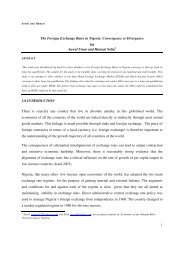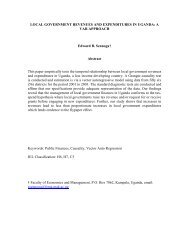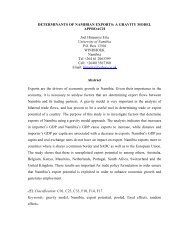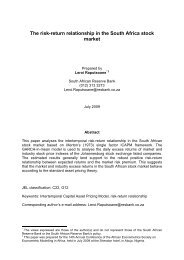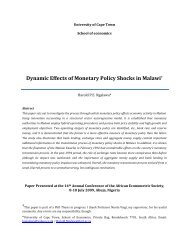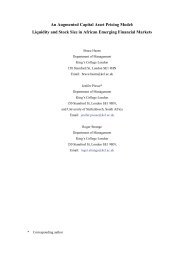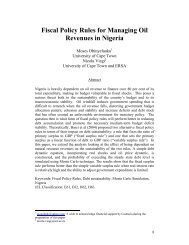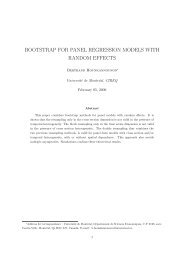Explaining Polarization and its Dimensions in Nigeria - African ...
Explaining Polarization and its Dimensions in Nigeria - African ...
Explaining Polarization and its Dimensions in Nigeria - African ...
Create successful ePaper yourself
Turn your PDF publications into a flip-book with our unique Google optimized e-Paper software.
<strong>in</strong>dex, <strong>and</strong> largely the work of Pyatt, (1976), Lambert <strong>and</strong> Aronso, (1993) <strong>and</strong> Araar (2006) on<br />
the decomposition of <strong>in</strong>equality <strong>in</strong>dex by sub-population groups. The idea is that between-group<br />
<strong>in</strong>equality represents the <strong>in</strong>equality of the group when each household has the average <strong>in</strong>come of<br />
<strong>its</strong> group. Then the algebraic decomposition of the G<strong>in</strong>i <strong>in</strong>dex takes the follow<strong>in</strong>g form:<br />
w<br />
A = ∑ϕ<br />
g<br />
ψ<br />
g<br />
Ag<br />
+ A + R<br />
g<br />
Where<br />
ϕ<br />
g<br />
<strong>and</strong><br />
ψ<br />
g<br />
are the population <strong>and</strong> <strong>in</strong>come shares of the group g respectively. A w is the<br />
between group <strong>in</strong>equality <strong>and</strong> equals to the G<strong>in</strong>i <strong>in</strong>dex when each member of the group has the<br />
average <strong>in</strong>come of <strong>its</strong> group. It is good to note that if <strong>in</strong>comes do not overlap, the residual part<br />
(R) of this decomposition vanishes (Araar, 2008). It follows that group with low residual of<br />
relative contribution will have high explanatory power of the polarization. This decomposition of<br />
G<strong>in</strong>i <strong>in</strong>dex helps to shed light on the decomposition of polarization as we can use the <strong>in</strong>dicator<br />
R/A to assess the explanatory power of the <strong>in</strong>terest group to polarization. This we applied to the<br />
decomposition of the DER <strong>in</strong>dex by population groups follow<strong>in</strong>g Araar (2008). Here our groups<br />
comprise of zone, sector, educational groups, occupational groups <strong>and</strong> sex.<br />
From (2), DER could <strong>in</strong> a way be written as:<br />
[ ]<br />
P= AI( α) 1+ ρ<br />
(9)<br />
(8)<br />
where<br />
1+<br />
α<br />
I( α ) f( y)<br />
dy<br />
= ∫ is the average identification component, A the G<strong>in</strong>i coefficient <strong>and</strong> the<br />
parameter ρ is the normalized covariance between alienation <strong>and</strong> identification which is equals<br />
to<br />
x<br />
α<br />
( [ ])( ⎡ ⎤)<br />
∫ ax ( ) = Ea f( x) −E ⎣<br />
f ⎦<br />
f( xdx )<br />
ρ = (10)<br />
AI<br />
12



